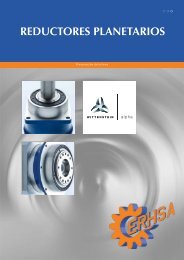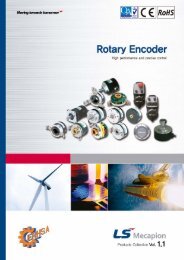Download PDF
Download PDF
Download PDF
- No tags were found...
You also want an ePaper? Increase the reach of your titles
YUMPU automatically turns print PDFs into web optimized ePapers that Google loves.
INTORQ I Clutch-brake combinations I en 5/2007AccessoriesINTORQ 14.640.10.048 EDS 48 electronic dual switchConnection examplesControl via continuous signalsSwitching via contactPressing the a2 switch turns the brake "off" and the clutch"on" (start), if a1 is not closed. If a2 is opened, the clutchswitches "off" and the brake "on" (stop). The first startcommand is executed no earlier than approximately1 second after the mains voltage is switched on or after a1is opened.Fig. 1Switching via optocouplerThis example is as Fig. 1, but an optocoupler or a transistoris used instead of a contact.Fig. 2Switching via proximity switchThis example is as Fig. 1, but a PNP proximity switch is usedinstead of a contact.Colours: bk. = black/bl. = blue/br. = brownProximity switch damped = clutch "on"/brake "off"Proximity switch free = brake "on"/clutch "off"bk.Fig. 3Switching via PLCIn this example, a PLC with a control voltage of 10 to 30 V isused for control.Control voltage "on" = clutch "on"/brake "off"Control voltage "off" = brake "on"/clutch "off"Fig. 4CautionThe cables to the coil must not short-circuit or have aconductive connection to earth (electrical bonding), thePEN conductor or other coils.51






